Whirlpool RCS2002G, RCS2012G, RCS3004G, RCS3614G, RCS3014G User Manual
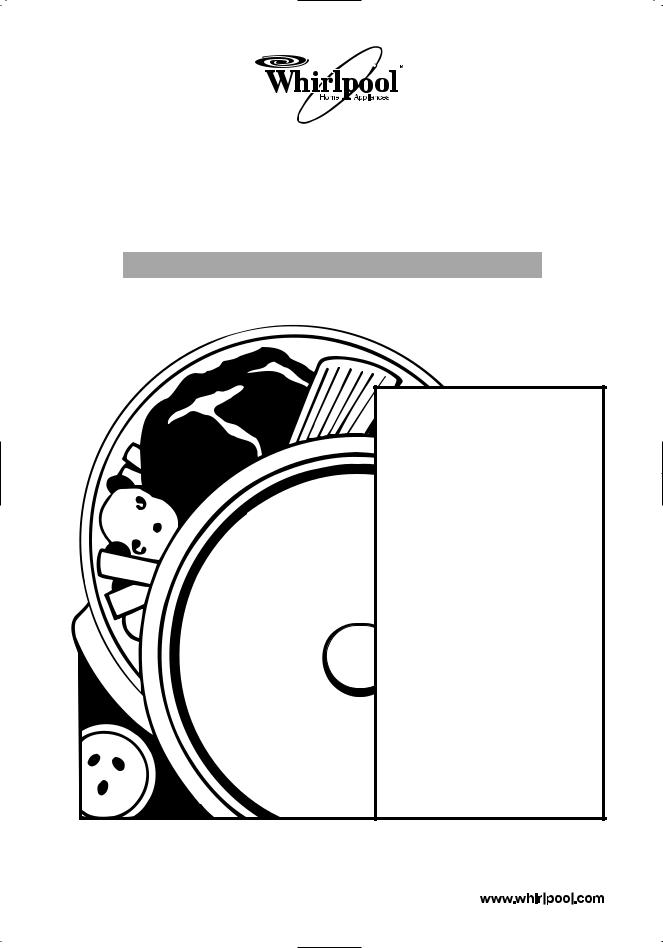
Use And Care
G U I D E
A Note To You............. |
2 |
Important Safety |
|
Instructions ................. |
3 |
Parts And Features..... |
5 |
Using Your Cooktop... |
6 |
Caring For |
|
Your Cooktop.............. |
9 |
Troubleshooting ....... |
12 |
Requesting |
|
Assistance |
|
Or Service.................. |
13 |
Warranty.................... |
15 |
In the U.S.A., for assistance or service, call the Consumer Assistance Center.
1-800-253-1301
In Canada for assistance or service, see page 14.
ELECTRIC COOKTOPS
MODELS RCS2002G RCS2012G RCS3004G
RCS3014G RCS3614G
3191535

A Note to You
Thank you for buying a WHIRLPOOL® appliance.
The Whirlpool Brand is committed to designing quality products that consistently perform for you to make your life easier. To ensure that you enjoy years of trouble-free operation, we developed this Use and Care Guide. It is full of valuable information about how to operate and maintain your appliance properly and safely. Please read it carefully.
Also, please complete and mail in the Product Registration Card provided with your appliance. The card helps us notify you about any new information on your appliance.
Please record your model’s information.
Whenever you call to request service for your appliance, you need to know your complete model number and serial number. You can find this information on the model and serial number label/plate (see diagram in the “Parts and Features” section).
Please also record the purchase date of your appliance and your dealer’s name, address, and telephone number.
Model Number _________________________
Serial Number _________________________
Purchase Date _________________________
Dealer Name __________________________
Dealer Address ________________________
Dealer Phone __________________________
Keep this book and the sales slip together in a safe place for future reference. It is important for you to save your sales receipt showing the date of purchase. Proof of purchase will assure you of in-warranty service.
In the U.S.A., call our Consumer |
- - |
Assistance Center toll free. |
1 800 253-1301 |
To find detailed product information, the location of the nearest Whirlpool dealer or authorized servicer, to purchase an accessory item, or register your appliance on-line, please visit our Web site at www.whirlpool.com
In Canada, for assistance or service, see the ”If You Need Assistance or Service” section.
In Canada visit our Web site at www.whirlpool.com/canada
2
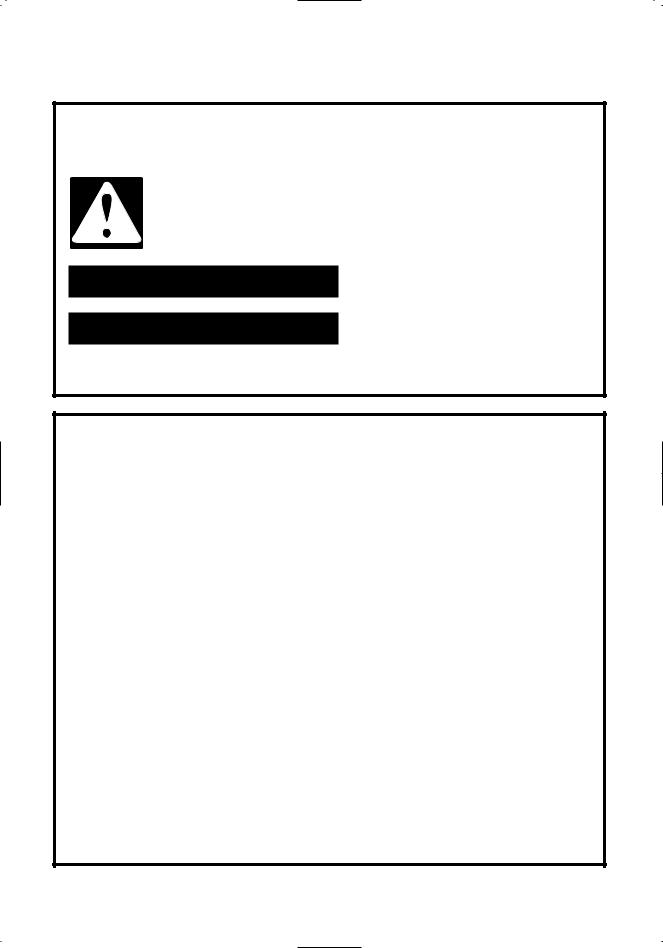
Important Safety Instructions
Your safety and the safety of others is very important.
We have provided many important safety messages in this manual and on your appliance. Always read and obey all safety messages.
This is the safety alert symbol.
This symbol alerts you to hazards that can kill or hurt you and others.
All safety messages will be preceded by the safety alert symbol and the word “DANGER” or “WARNING.” These words mean:
wDANGER
wWARNING
You will be killed or seriously injured if you don’t follow instructions.
You can be killed or seriously injured if you don’t follow instructions.
All safety messages will identify the hazard, tell you how to reduce the chance of injury, and tell you what can happen if the instructions are not followed.
IMPORTANT SAFETY INSTRUCTIONS
WARNING – To reduce the risk of fire, electrical shock, injury to persons, or damage when using the cooktop, follow basic precautions, including the following:
• CAUTION – Do not store items of interest to children in cabinets above a cooktop – Children climbing on
the cooktop to reach items could be seriously injured.
•Proper Installation – Be sure your cooktop is properly installed and grounded by a qualified technician.
•Never Use Your Cooktop for Warming or Heating the Room.
•Do Not Leave Children Alone – Children should not be left alone or unattended in area where cooktop is in use. They should never be allowed to sit or stand on any part of the cooktop.
•User Servicing – Do not repair or replace any part of the cooktop unless specifically recommended in the manual. All other servicing should be referred to a qualified technician.
•Storage on Cooktop – Flammable materials should not be stored near surface units.
•Do Not Use Water on Grease Fires – Smother fire or flame or use dry chemical or foam-type extinguisher.
•Use Only Dry Potholders – Moist or damp potholders on hot surfaces may result in burns from steam. Do not let potholder touch hot heating elements. Do not use a towel or other bulky cloth.
•Wear Proper Apparel – Loose-fitting or hanging garments should never be worn while using the cooktop.
–SAVE THESE INSTRUCTIONS –
continued on next page
3
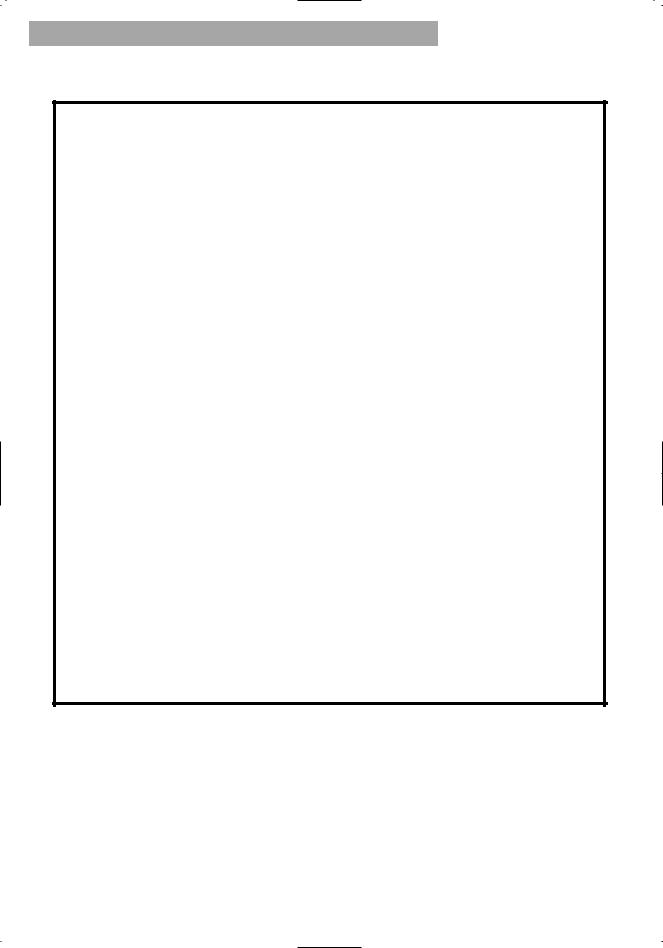
IMPORTANT SAFETY INSTRUCTIONS
IMPORTANT SAFETY INSTRUCTIONS
•DO NOT TOUCH SURFACE UNITS OR AREAS NEAR UNITS – Surface units may be hot even though they are dark in color. Areas near surface units may become hot enough to cause burns. During and after use, do not touch, or let clothing or other flammable materials contact surface units or areas near units until they have had sufficient time to cool. Among those areas are the cooktop and surfaces facing the cooktop.
•Use Proper Pan Size – This cooktop is equipped with one or more surface units of different size. Select utensils having flat bottoms large enough to cover the surface unit heating element. The use of undersized utensils will expose a portion of the heating element to direct contact and may result in ignition of clothing. Proper relationship of utensil to burner will also improve efficiency.
•Never Leave Surface Units Unattended at High Heat Settings – Boilover causes smoking and greasy spillovers that may ignite.
•Glazed Cooking Utensils – Only certain types of glass, glass/ceramic, ceramic, earthenware, or other glazed utensils are suitable for cooktop service without breaking due to the sudden change in temperature.
•Utensil Handles Should Be Turned Inward and Not Extend Over Adjacent Surface Units – To reduce the risk of burns, ignition of flammable materials, and spillage due to unintentional contact with the utensil, the handle of a utensil should be positioned so that it is turned inward, and does not extend over adjacent surface units.
•Do Not Cook on Broken Cooktop – If cooktop should break, cleaning
solutions and spillovers may penetrate the broken cooktop and create a risk of electric shock. Contact a qualified technician immediately.
•Clean Cooktop With Caution – If a wet sponge or cloth is used to wipe spills on a hot cooking area, be careful to avoid steam burn. Some cleaners can produce noxious fumes if applied to a hot surface.
For units with ventilating hood –
•Clean Ventilating Hoods Frequently – Grease should not be allowed to accumulate on hood or filter.
•When flaming foods under the hood, turn the fan off. The fan, if operating, may spread the flame.
– SAVE THESE INSTRUCTIONS –
4
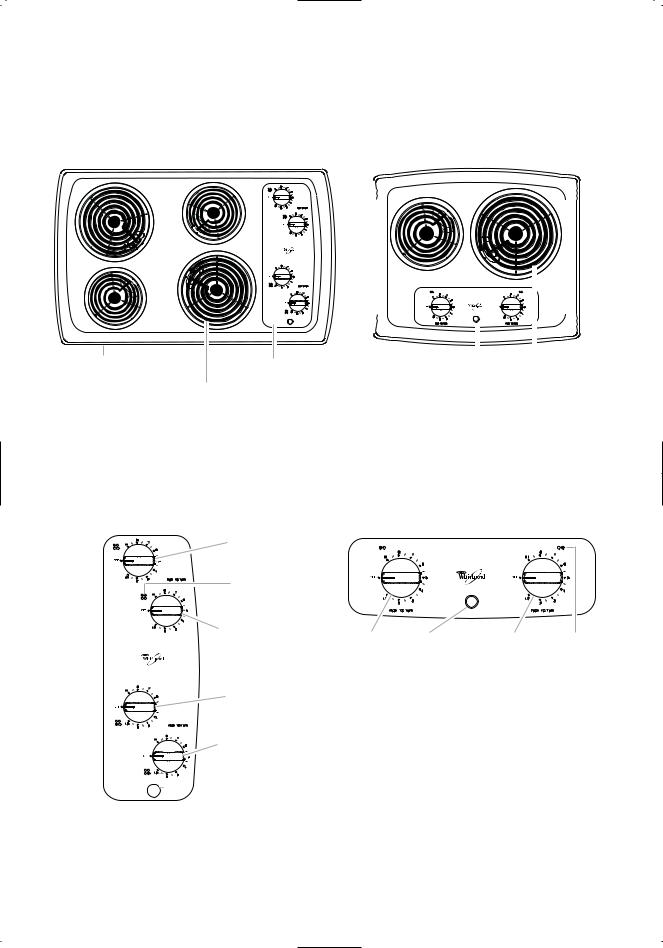
Parts And Features
Models RCS3004G, |
Models RCS2002G, RCS2012G |
RCS3014G, RCS3614G |
|
Model and serial number plate (located on outside bottom of cooktop)
Control panel
Plug-in coil element with one-piece reflector bowl
|
|
|
|
|
|
|
|
|
|
|
|
|
|
|
|
|
|
|
|
|
|
|
|
|
|
|
|
|
|
|
|
|
|
|
|
|
|
|
|
|
|
|
|
|
|
|
|
|
|
|
|
|
|
|
|
|
|
|
|
|
|
|
|
|
|
|
|
|
|
Model and serial |
|
|
Plug-in coil |
||||||
number plate |
|
|
element with |
||||||
(located on outside |
Control |
one-piece |
|||||||
bottom of cooktop) |
reflector bowl |
||||||||
panel |
|||||||||
|
|
|
|
|
|
|
|||
Control panels
Models RCS3004G, |
Models RCS2002G, |
|
||
RCS3014G, RCS3614G |
RCS2012G |
|
|
|
Left rear |
|
|
|
|
control knob |
|
|
|
|
Surface |
|
|
|
|
cooking area |
|
|
|
|
marker |
|
|
|
|
Right rear |
Left front |
Power |
Right front |
Surface |
control knob |
||||
|
control |
On |
control |
cooking |
|
knob |
indicator |
knob |
area marker |
|
|
light |
|
|
Left front |
|
|
|
|
control knob |
|
|
|
|
Right front control knob
Power On

 indicator light
indicator light
5
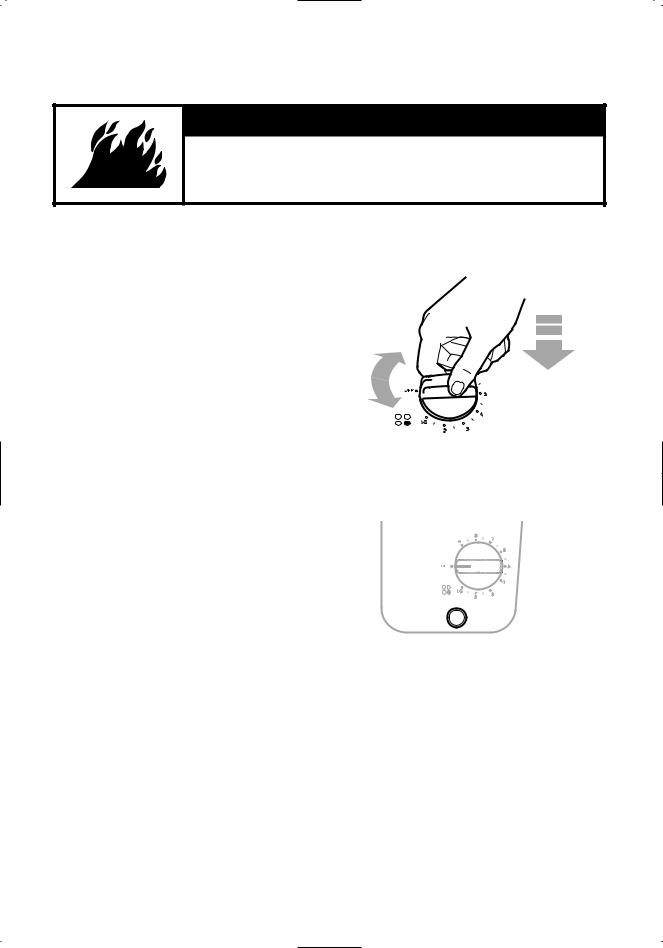
Using Your Cooktop
wWARNING
Fire Hazard
Turn off all controls when done cooking.
Failure to do so can result in death or fire.
Using the surface cooking area
Push in control knobs before turning them to a setting. You can set them anywhere between HI and OFF.
Surface cooking area markers
The solid dot in the surface cooking area marker shows which coil element is turned on by that knob.
(Models RCS3614G, RCS3004G, RCS3014G shown)
Power On indicator light
The Power On indicator light will glow when any of the coil element(s) are turned on.
(Models RCS3614G, RCS3004G, RCS3014G shown)
6

USING YOUR COOKTOP
Until you get used to the settings, use the following as a guide. For best results, start cooking at the high setting; then turn the control knob down to continue cooking.
SETTING |
RECOMMENDED USE |
|
|
HI |
• To start food cooking. |
|
• To bring liquid to a boil. |
|
|
MED-HI or 6-8 |
• To hold a rapid boil. |
|
• To quickly brown or sear meat. |
|
|
MED or 5 |
• To maintain a slow boil. |
|
• To fry poultry or meat. |
|
• To make pudding, sauce, or gravy. |
|
|
MED-LO or 2-4 |
• To stew or steam food. |
|
• To simmer food. |
|
|
LO |
• To keep food warm. Set the heat higher or lower within the |
|
LO (or 1) band to keep food at the temperature you want. |
|
• To maintain liquid just below simmer. |
|
• To melt chocolate or butter. |
|
|
Home canning information
 Pan
Pan
Center over coil element
Coil element
•Use flat-bottomed canners on all types of cooktops, especially ceramic glass. Canners with rippled or ridged bottoms do not allow good contact with the surface.
•Center the canner over the largest coil element. Do not extend more than one inch outside the coil element. Large diameter canners/pans, if not centered correctly, trap heat and can cause damage to the cooktop.
•Do not place your canner on two coil elements at the same time.
•The type of material the canner is made of determines the length of heating time. Refer to the “Characteristics of cookware materials” chart later in this section for more information.
•When canning for long periods of time, allow elements and the surrounding surfaces to cool down.
•Alternate use of the coil elements between batches or prepare small batches at a time.
•Start with hot water, cover with a lid, and bring to a boil; then reduce heat to maintain a boil or required pressure levels in a pressure canner.
•Keep reflector bowls clean so that they will always reflect heat well.
•For up-to-date information on canning, contact your local U.S. Government Agricultural Department Extension Office or companies who manufacture home canning products.
Optional canning kit
Most water-bath or pressure canners have large diameters. If you do canning with them at high heat settings for long periods of time, you can shorten the life of regular coil elements. This can also damage the cooktop. If you plan to use the cooktop for canning, we recommend the installation of
a Canning Kit. Order the kit (Part No. 242905) from your dealer or authorized service company.
7

USING YOUR COOKTOP
Characteristics of cookware materials
The pan material affects how fast heat transfers from the coil element through the pan material and how evenly heat spreads over the pan bottom. Choose pans that provide the best cooking results.
Aluminum |
• Heats quickly and evenly. |
|
• Use for all types of cooking. |
|
• Medium or heavy thickness is best for most cooking. |
|
• Used as a core or base in cookware to provide even heating. |
Cast iron |
• Heats slowly and evenly. |
|
• Good for browning and frying. |
|
• Maintains heat for slow cooking. |
|
• Can be coated with porcelain enamel. |
Ceramic or ceramic glass
Copper
•Heats slowly and unevenly.
•Use on low to medium settings.
•Follow manufacturer’s instructions.
•Heats very quickly and evenly.
•Used as a core or base in cookware to provide even heating.
Earthenware |
• Can be used for cooktop cooking if recommended by the |
|
manufacturer. |
|
• Use on low settings. |
Porcelain enamel-on-steel or enamel-on-cast iron
Stainless steel
•See cast iron and stainless steel.
•Heats quickly but unevenly.
•A core or base of aluminum or copper on the cookware provides even heating.
•Can be coated with porcelain enamel.
Cookware tips
•Select a pan that is about the same size as the coil element. Cookware should not extend more than 1 inch (2.5 cm) outside the area.
•For best results and greater energy efficiency, use only flat-bottomed cookware that makes good contact with the coil element. Cookware with rounded, warped, ribbed (such as some porcelain enamelware), or dented bottoms could cause uneven heating and poor cooking results.
•Cookware with non-stick finish has heating characteristics of the base material.
•Use flat bottom cookware for best heat conduction from the coil element to the cookware. Determine flatness with the ruler test. Place the edge of a ruler across the bottom of the cookware. Hold it up to the light. No light should be visible under the ruler. Rotate the ruler in all directions and look for any light.
•Do not leave empty cookware, or cookware that has boiled dry, on a hot
coil element. The cookware could overheat, causing damage to the cookware or the coil element.
8
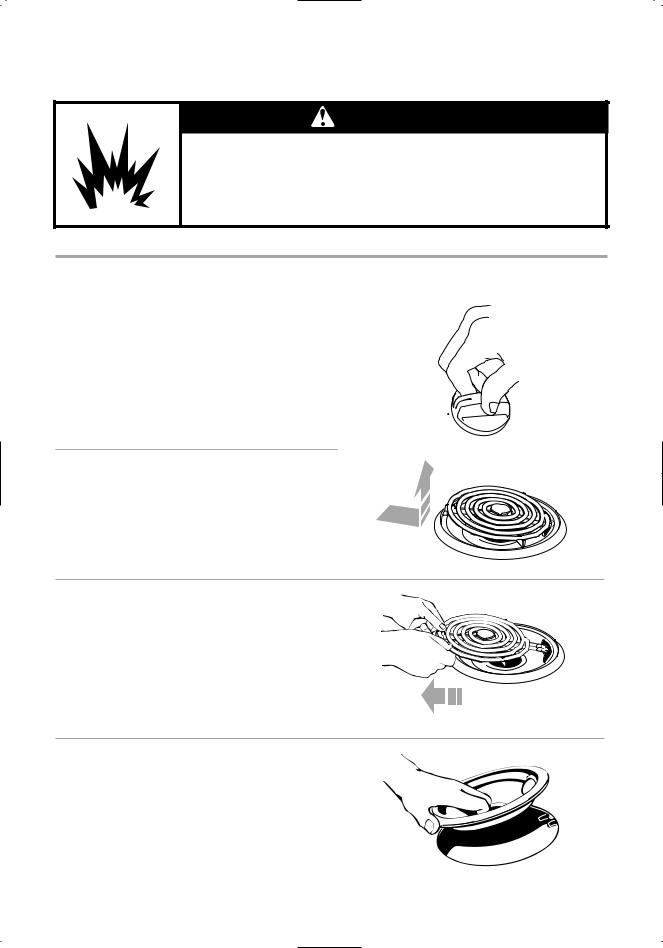
Caring For Your Cooktop
WARNING
Explosion Hazard
Do not store flammable materials such as gasoline near this appliance.
Doing so can result in death, explosion, or fire.
Coil elements and reflector bowls
Removing
1.Make sure all coil elements are off and cool before removing coil elements and
reflector bowls.
2.Push in the edge of the coil element, opposite the receptacle. Then lift it just
enough to clear the reflector bowl.
3. Pull the coil element straight away from the receptacle.
4.Lift out the reflector bowl. See the “Cleaning chart” later in this section
for cleaning instructions.
continued on next page
9
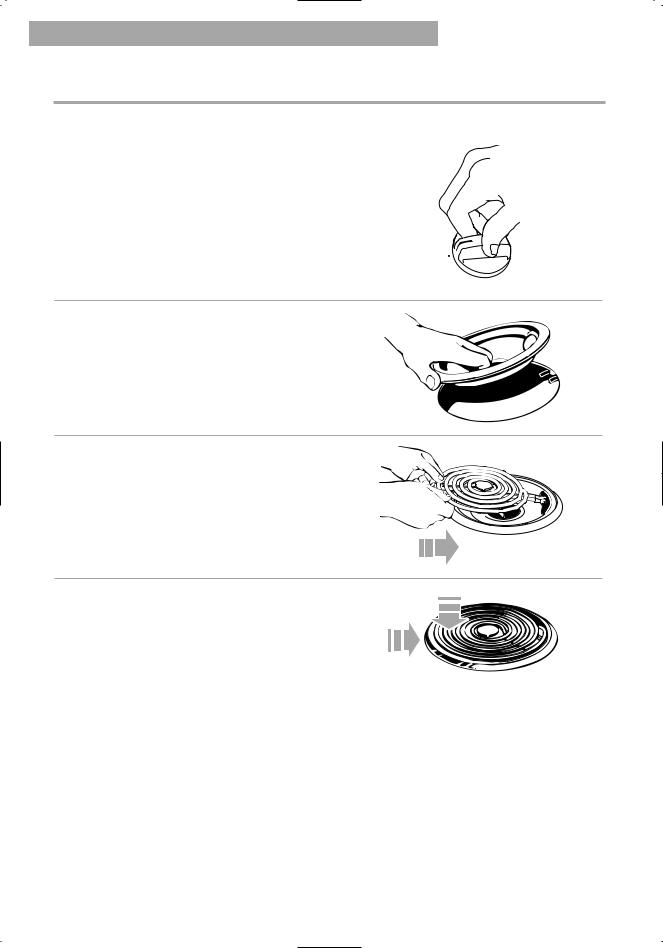
CARING FOR YOUR COOKTOP
Coil elements and reflector bowls (cont.)
Replacing
1.Make sure all coil elements are off and cool before replacing coil elements and
reflector bowls.
2. Line openings in the reflector bowl with the coil element receptacle.
3. Hold the coil element as level as possible with the terminal just started into the receptacle. Push the coil element terminal into the receptacle.
4.When the terminal is pushed into the receptacle as far as it will go, push down the edge of the coil element opposite the receptacle.
NOTE: Reflector bowls reflect heat back to the cookware on the coil elements. They also help catch spills. When they are kept clean, they reflect heat better and look new longer.
If a reflector bowl changes color, some of your cookware may not be flat enough, or some may be too large for the coil element. In either case, some of the heat that’s meant to go into or around cookware goes down and heats the reflector bowl. This extra heat can cause it to change color.
10
